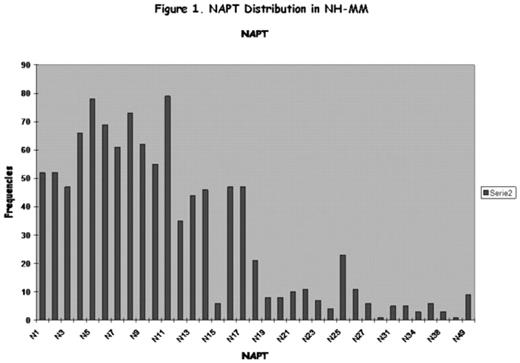Abstract
Background Multiple myeloma (MM) is presently an incurable plasma cell (PC) malignancy which involves 16 000 new patients per year in US. In spite of the abundance of cytogenetic information, with more than 600 published karyotypes in Non-hyperdiploid MM (NHMM), very little is known about the mode of karyotypic evolution or of the presence of possible cytogenetic pathways. In our investigation, we have used 647 NHMM karyotypes, to identify the most frequently occurring imbalances. Patients and Methods The Mitelman database of Chromosome aberrations in cancer (Mitelman et al., 2007) was searched, and myelomas with modal chromosome number less than 48 were selected. All karyotypes were described using ISCN nomenclature (ISCN, 1995). Only the main clones were analyzed and incomplete karyotypes were excluded. The following information was obtained from each karyotype: chromosome number, imbalances including whole chromosome gains and losses; specific translocations and breakpoints, including add chromosomes. An Excel spreadsheet in which the rows of the first column were labeled to represent each band of a 360-band human chromosome ideogram was created as previously described (Hoglund et al., 2001; Horsman et al., 2003) All karyotypes were scored individually in successive columns for net gain and loss of each chromosome band. The total number of gains and losses affecting each chromosome band for the total cohort of karyotypes was then calculated using the Excel countif function. Recurrent abnormalities were defined as those that were involved in >5% of cases. Histograms of the number of abnormalities per tumor were then plotted, and the modal value extracted as variable called time to occurrence. Statistics correlation between the presence and absence of different abnormalities was analyzed using Spearman correlation matrices. P value of <0.05 was considered as statistical significant. Results In total 647 cases of newly diagnosed NHMM were included in the analysis. The median chromosome number was 43. Few cases had chromosome numbers under 40. The median NAPT was 12 (1–49) with a normal distribution (Fig 1). The most common abnormalities were monosomies of the chromosomes 13 and 14 (32.44% and 14.88% respectively). Out of 647 cases, more than 300 NHMM cases contained translocations in their karyotypes. The most common translocation was t(11;14), which occurs in 17% of cases followed by t(1;16) in 2.7% of cases and t(4;14) and t(8;14) in 1.5% respectively. The most recurrent breakpoints in our series include: 14q32 (32%), 11q13 (20%), 1q10 (10.5%), 1q12 (8%), 8q24 (6.9%), 1p11 (6.6%) and 1q21 (5.5%). Discussion Although only about 40% of MM has informative karyotypes, karyotyping has the advantage of representing global genetic changes at the cellular level. In this comprehensive survey, loss of chromosome 13 and 14 were the most common abnormalities. The NAPT analysis suggests that most NHMM patients have at least 12 abnormalities at diagnosis. It is possible that accumulation of abnormalities above a threshold results in malignant transformation. In our series the t(11;14) translocation appears to be the most recurrent translocation and exceeds the rate reported in Hyperdiploid-MM (17% vs 3.8%).
Author notes
Disclosure: No relevant conflicts of interest to declare.


